Quantities, Determinants, and Awareness of Households’ Food Waste in Italy: A Comparison between Diary and Questionnaires Quantities
Abstract
1. Introduction
2. Materials and Methods
2.1. Experiment Design and Tools
2.2. Sampling
2.3. Definitions
2.4. Data Analysis
3. Results
3.1. Household Demographics
3.2. General Food Waste Results: Quantity and Causes
3.3. Motivations, Consumption Habits and Food Waste Quantities
3.4. Disposal of Wasted Food
3.5. Extent to Which the Selected Variables Determine Food Waste
3.6. Awareness of Food Waste Quantities
4. Discussion
5. Conclusions
Author Contributions
Funding
Acknowledgments
Conflicts of Interest
References
- FAO. Global Food Losses and Food Waste—Extent, Causes and Prevention; FAO: Rome, Italy, 2011; Available online: http://www.fao.org/3/a-i2697e.pdf (accessed on 10 October 2018).
- Abeliotis, K.; Lasaridi, K.; Chroni, C. Attitudes and behavior of Greek households regarding food waste prevention. Waste Manag. Res. 2014, 32, 237–240. [Google Scholar] [CrossRef]
- Parizeau, K.; von Massow, M.; Martin, R. Household level dynamics of food waste production and related beliefs, attitudes and behaviors in Guelph, Ontario. Waste Manag. 2015, 35, 201–217. [Google Scholar] [CrossRef]
- SDG 12.3. n.d. Available online: https://champions123.org/target-12-3/ (accessed on 27 July 2018).
- Directive 2018/851 of the European Parliament and of the Council of 30 May 2018, Amending Directive 2008/98/EC on Waste Directive (EU) 2018/851. Available online: https://eur-lex.europa.eu/legal-content/EN/TXT/?uri=CELEX:32018L0851 (accessed on 2 February 2019).
- COMMISSION DELEGATED DECISION (EU) 3211 Final of 3rd of May 2019 Supplementing Directive 2008/98/EC of the European Parliament and of the Council as Regards a Common Methodology and Minimum Quality Requirements for the Uniform Measurement of Levels of Food Waste and Annex. Available online: http://ec.europa.eu/transparency/regdoc/rep/3/2019/EN/C-2019-3211-F1-EN-MAIN-PART-1.PDF (accessed on 10 May 2019).
- Stefan, V.; Van Herpen, E.; Tudoran, A.; Lahteenmaki, L. Avoiding food waste by Romanian consumers: The importance of planning and shopping routines. Food Qual. Prefer. 2013, 28, 375–381. [Google Scholar] [CrossRef]
- Quested, T.E.; Marsh, E.; Stunell, D.; Parry, A.D. Spaghetti soup: The complex world of food waste behaviours. Resour. Conserv. Recycl. 2013, 79, 43–51. [Google Scholar] [CrossRef]
- Jörissen, J.; Priefer, C.; Bräutigam, K.R. Food Waste Generation at Household Level: Results of a Survey among Employees of Two European Research Centers in Italy and Germany. Sustainability 2015, 7, 2695–2715. [Google Scholar] [CrossRef]
- Vermeir, I.; Verbeke, W. Sustainable Food Consumption: Exploring the Consumer “Attitude–Behavioral Intention” Gap. J. Agric. Environ. Ethics 2006, 19, 169. [Google Scholar] [CrossRef]
- Gaiani, S.; Caldeira, S.; Adorno, V.; Segrè, A.; Vittuari, M. Food wasters: Profiling consumers’ attitude to waste food in Italy. Waste Manag. 2017, 72, 17–24. [Google Scholar] [CrossRef]
- Camillo, F.; Adorno, V. Lo Spreco Alimentare Nelle Famiglie Italiane; Waste Watcher: Bologna, Italy, 2013. [Google Scholar]
- Last Minute Market and SWG. Waste Watcher: Observatory of Italian Household Food Waste 2012; Last Minute Market: Bologna, Italy, 2013. [Google Scholar]
- Last Minute Market and SWG. Waste Watcher: Observatory of Italian Household Food Waste 2013; Last Minute Market: Bologna, Italy, 2014. [Google Scholar]
- Last Minute Market and SWG. Waste Watcher: Observatory of Italian Household Food Waste 2014; Last Minute Market: Bologna, Italy, 2015. [Google Scholar]
- Last Minute Market and SWG. Waste Watcher: Observatory of Italian Household Food Waste 2015; Last Minute Market: Bologna, Italy, 2016. [Google Scholar]
- Setti, M.; Falasconi, L.; Segrè, A.; Cusano, I.; Vittuari, M. Italian consumers’ income and food waste behavior. Br. Food J. 2016, 118, 1731–1746. [Google Scholar] [CrossRef]
- Fanelli, R.M. Using Causal Maps to Analyze the Major Root Causes of Household Food Waste: Results of a Survey among People from Central and Southern Italy. Sustainability 2019, 11, 1183. [Google Scholar] [CrossRef]
- Romani, S.; Grappi, S.; Bagozzi, R.; Barone, A.M. Domestic food practices: A study of food management behaviors and the role of food preparation planning in reducing waste. Appetite 2018, 121, 215–227. [Google Scholar] [CrossRef]
- Grosso, M.; Falasconi, L. Addressing food wastage in the framework of the UN Sustainable Development Goals. Waste Manag. Res. 2018, 36, 97–98. [Google Scholar] [CrossRef]
- Langley, J.; Yoxall, A.; Heppell, G.; Rodriguez, E.M.; Bradbury, S.; Lewis, R.; Luxmoore, J.; Hodzic, A.; Rowson, J. UK pilot study testing a methodology for compositional domestic food waste analysis. Waste Manag. Res. 2010, 28, 220–227. [Google Scholar] [CrossRef]
- WRAP. Household Food and Drink Waste in the UK 2012; Waste and Resources Action Programme: Banbury, UK, 2013; Available online: http://www.wrap.org.uk/sites/files/wrap/hhfdw-2012-main.pdf.pdf (accessed on 11 September 2019).
- Koivupuro, H.K.; Hartikainen, H.; Katajajuuri, J.M.; Heikintalo, M.; Reinikaninen, A.; Jalkanen, L. Influence of socio-demographical, behavioural and attitudinal factors on the amount of avoidable food waste generated in Finnish households. Int. J. Consum. Stud. 2012, 6, 183–191. [Google Scholar] [CrossRef]
- Silvennoinen, K.; Katajajuuri, J.M.; Hartikainen, H.; Heikkila, L.; Reinikainen, A. Food waste volume and composition in Finnish households. Br. Food J. 2014, 116, 1058–1068. [Google Scholar] [CrossRef]
- Edjabou, M.E.; Petersen, C.; Scheutz, C.; Astrup, T.F. Food waste from Danish households: Generation and composition. Waste Manag. 2016, 52, 256–268. [Google Scholar] [CrossRef]
- Aschemann-Witzel, J.; De Hooge, I.; Amani, P.; Bech-Larsen, T.; Oostindjer, M. Consumer-Related Food Waste: Causes and Potential for Action. Sustainability 2015, 7, 6457–6477. [Google Scholar] [CrossRef]
- Schanes, K.; Dobernig, K.; Gözet, B. Food waste matters—A systematic review of household food waste practices and their policy implications. J. Clean. Prod. 2018, 182, 978–991. [Google Scholar] [CrossRef]
- Baker, D.; Fear, J.; Denniss, R. What a Waste: An Analysis on Households Expenditure on Food; The Australian Institute: Manuka, Australia, 2019; Available online: http://www.tai.org.au/sites/default/files/PB%206%20What%20a%20waste%20final_7.pdf (accessed on 10 September 2018).
- Giordano, C.; Alboni, F.; Cicatiello, C.; Falasconi, L. Do discounted food products end up in the bin? An investigation into the link between deal-prone shopping behavior and quantities of household food waste. Int. J. Consum. Stud. 2018, 1–11. [Google Scholar] [CrossRef]
- Secondi, L.; Principato, T. Laureti Household food waste behaviour in EU-27 countries: A multilevel analysis. Food Policy 2015, 56, 25–40. [Google Scholar] [CrossRef]
- Stancu, V.; Haugaard, P.; Lähteenmäki, L. Determinants of consumer food waste behaviour: Two routes to food waste. Appetite 2016, 96, 7–17. [Google Scholar] [CrossRef]
- Visschers, V.H.; Wickli, N.; Siegrist, M. Sorting out food waste behaviour: A survey on the motivators and barriers of self-reported amounts of food waste in households. J. Environ. Psychol. 2016, 45, 66–78. [Google Scholar] [CrossRef]
- Qi, D.; Roe, B.E. Household food waste: Multivariate regression and principal components analyses of awareness and attitudes among US consumers. PLoS ONE 2016, 11, e0159250. [Google Scholar] [CrossRef] [PubMed]
- Aschemann-Witzel, J.; Jensen, J.H.; Jensen, M.H.; Kulikovskaja, V. Consumer behavior towards price-reduced suboptimal foods in the supermarket and the relation to food waste in households. Appetite 2017, 116, 246–258. [Google Scholar] [CrossRef] [PubMed]
- Evans, D. Beyond the Throwaway Society: Ordinary Domestic Practice and a Sociological Approach to Household Food Waste. Sociology 2012, 46, 41–56. [Google Scholar] [CrossRef]
- Giordano, C. Assessing Household Food Waste in Italy: A Methodology for Detecting Drivers and Quantities. Ph.D. Thesis, Department of Agricultural and Food Sciences, University of Bologna, Bologna, Italy, 2016. Available online: http://amsdottorato.unibo.it/7567/ (accessed on 12 January 2019).
- WRAP WE DON’T WASTE FOOD! A Householder Survey. Exodus Research 2007. Available online: https://www.yumpu.com/en/document/read/40583001/we-dont-waste-food-a-householder-survey-wrap (accessed on 10 September 2018).
- Tversky, A.; Kahneman, D. Availability: A heuristic for judging frequency and probability. Cogn. Psychol. 1973, 5, 207–232. [Google Scholar] [CrossRef]
- Festinger, L. A Theory of Cognitive Dissonance; Stanford University Press: Palo Alto, CA, USA, 1957. [Google Scholar]
- Giordano, C.; Piras, S.; Boschini, M.; Falasconi, L. Are questionnaires a reliable method to measure household food waste? Br. Food J. 2018, 120, 2885–2897. [Google Scholar] [CrossRef]
- ISTAT Rapporto Annuale 2016 La Situazione del Paese. 2016. Available online: https://www.istat.it/it/files//2016/04/Cap_2_Ra2016.pdf (accessed on 12 January 2019).
- OECD-FAO. OECD-FAO Agricultural Outlook 2017. Available online: http://stats.oecd.org/Index.aspx?datasetcode=HIGH_AGLINK_2017 (accessed on 12 January 2019).
- WRI, Food Loss and Waste Accounting and Reporting Standard. World Resource Institute: Washington, DC, USA, 2016. Available online: http://flwprotocol.org/wp-content/uploads/2017/05/FLW_Standard_final_2016.pdf (accessed on 19 January 2018).
- Stenmarck, A.; Jensen, C.; Quested, T.; Moates, G. Estimates of European Food Waste Levels; FUSIONS, 2016; Available online: https://www.eu-fusions.org/phocadownload/Publications/Estimates%20of%20European%20food%20waste%20levels.pdf (accessed on 19 March 2016).
- Strobl, C.; Boulesteix, A.L.; Zeileis, A.; Hothorn, T. Bias in random forest variable importance measures: Illustrations, sources and a solution. BMC Bioinform. 2007, 8, 25. [Google Scholar] [CrossRef]
- Neff, R.A.; Spiker, M.L.; Truant, P.L. Wasted Food: U.S. Consumers’ Reported Awareness, Attitudes, and Behaviors. PLoS ONE 2015, 10. [Google Scholar] [CrossRef]
- Monier et al. Preparatory Study on Food Waste. Final Report. EC_ DG ENV; BIOis 2010. Available online: http://ec.europa.eu/environment/eussd/pdf/bio_foodwaste_report (accessed on 15 October 2016).
- ISPRA. Rapporto Rifiuti Urbani Ed. 2017. Available online: http://www.isprambiente.gov.it/files2017/pubblicazioni/rapporto/RapportoRifiutiUrbani_Ed.2017n.273_Vers.Estratto_agg06_11_2017.pdf (accessed on 12 January 2018).
- Bernstad, A. Household food waste separation behavior and the importance of convenience. Waste Manag. 2014, 34, 1317–1323. [Google Scholar] [CrossRef]
- Ganglbauer, E.; Fitzpatrick, G.; Comber, R. Negotiating food waste: Using a practice lens to informdesign. ACM Trans. Comput.-Hum. Interact. 2013, 20, 2. [Google Scholar] [CrossRef]
- Graham-Rowe, E.; Jessop, D.C.; Sparks, P. Identifying motivations and barriers to minimizing household food waste. Res. Conserv. Recycl. 2014, 84, 15–23. [Google Scholar] [CrossRef]
- Gazzetta Ufficiale della Repubblica Italiana, Law n. 166 of the 19 August 2016 (Legge Gadda against Food Waste). Available online: https://www.gazzettaufficiale.it/eli/id/2016/08/30/16G00179/sg (accessed on 4 April 2019).
- Fanelli, R.M.; Di Nocera, A. How to implement new educational campaigns against food waste: An analysis of best practices in European Countries. Econ. Agroaliment./Food Econ. 2017, 19, 223–244. [Google Scholar] [CrossRef]
- Evans, D. Blaming the consumer once again: The social and material context of waste. Crit. Public Health 2011, 21, 429–440. [Google Scholar] [CrossRef]
- Cicatiello, C.; Giordano, C. Measuring household food waste at national level: A systematic review on methods and results. CAB Rev. Perspect. Agric. Vet. Sci. Nutr. Nat. Resour. 2019, 13, 1–8. [Google Scholar] [CrossRef]
- Mourad, M. Recycling, recovering and preventing “food waste”: Competing solutions for food systems sustainability in the United States and France. J. Clean. Prod. 2016, 126, 461–477. [Google Scholar] [CrossRef]
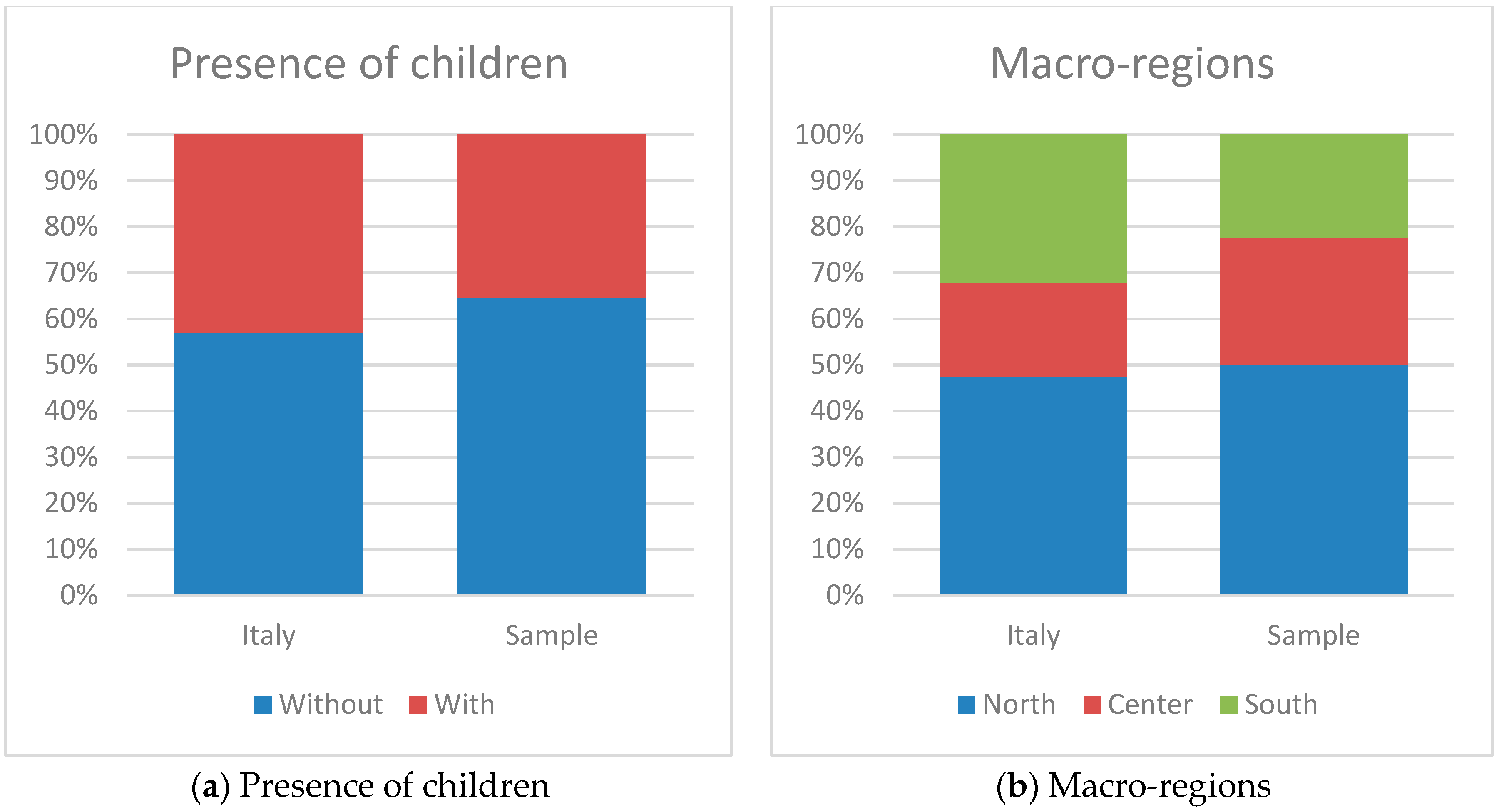
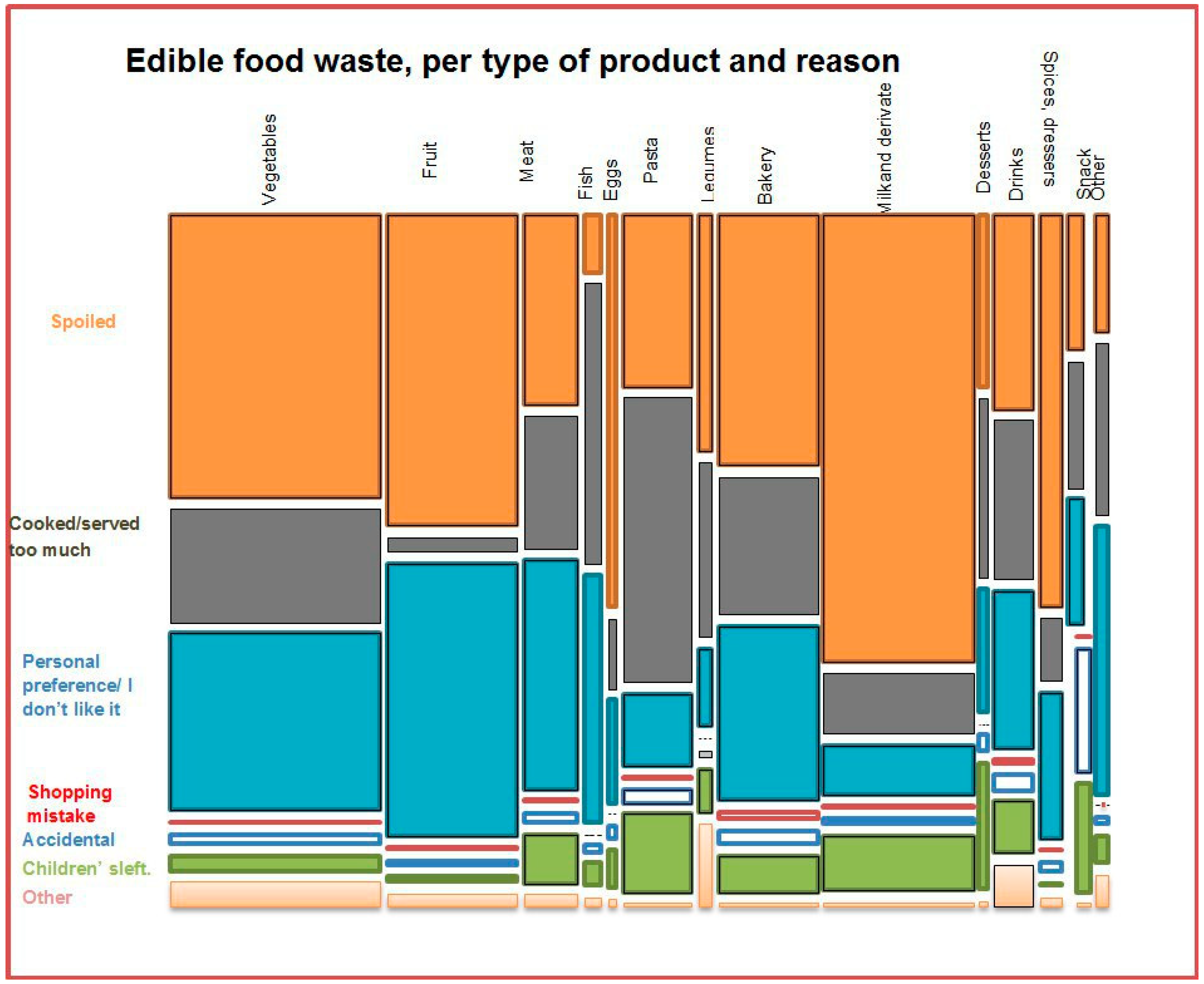
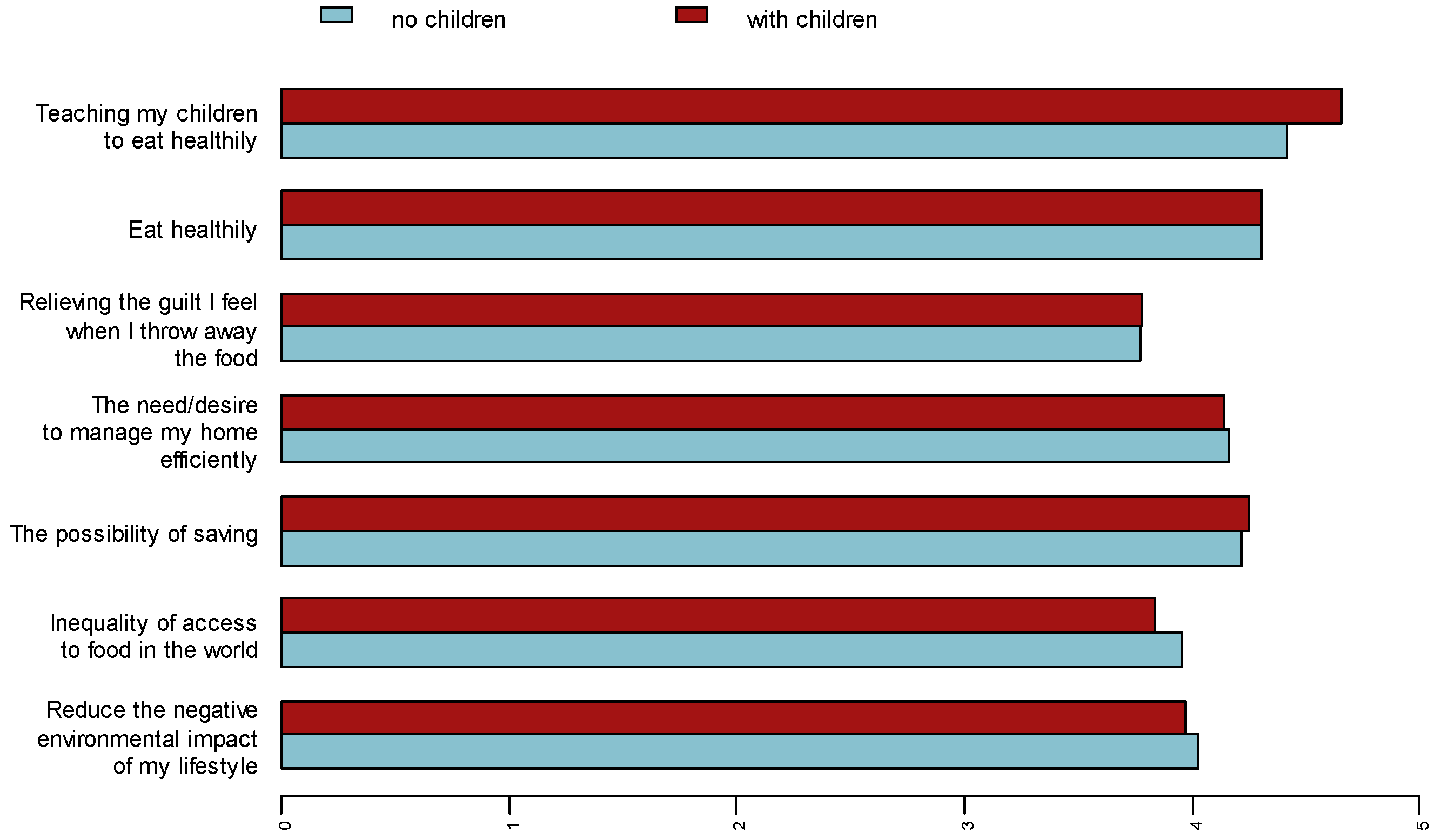
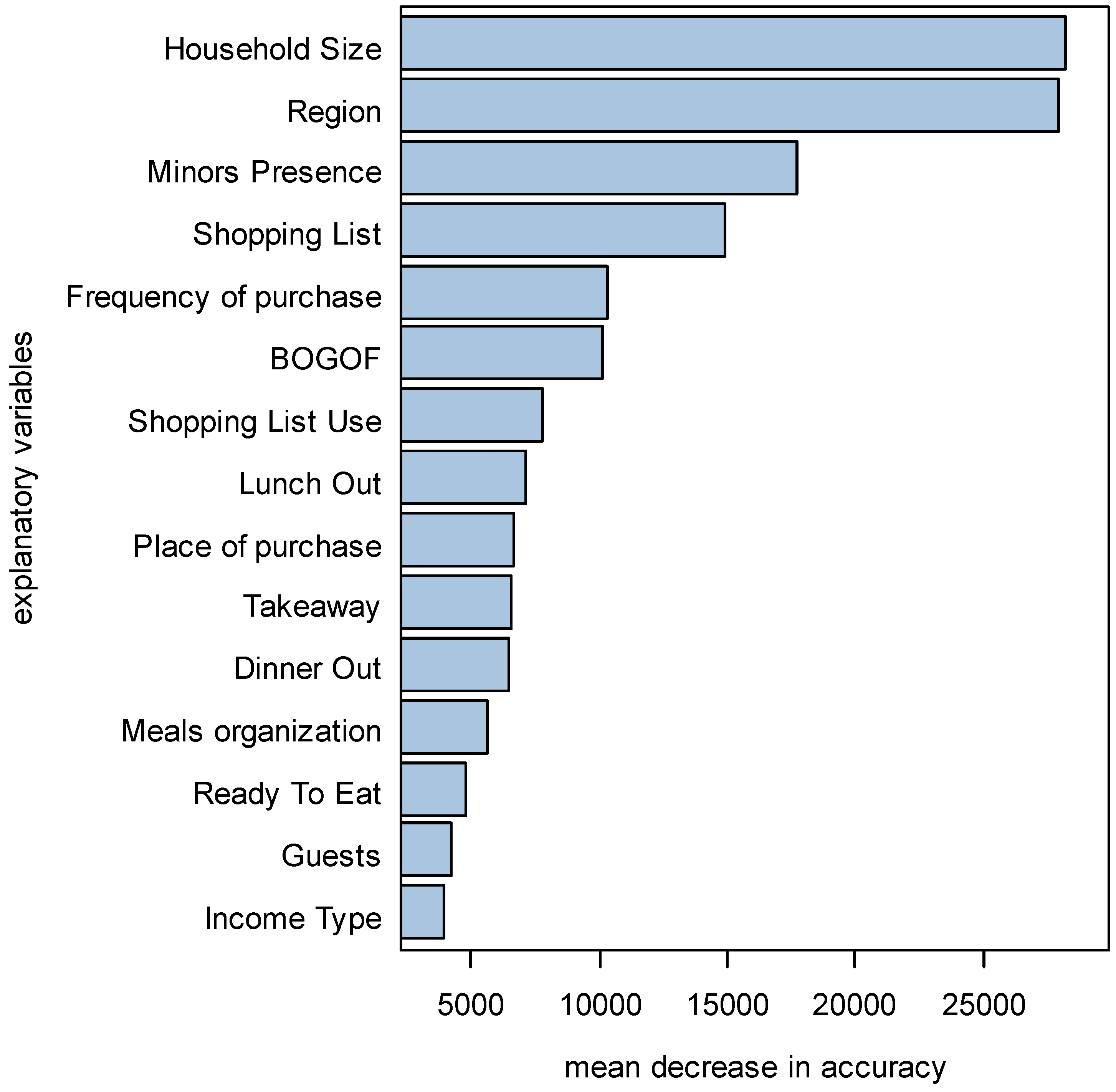
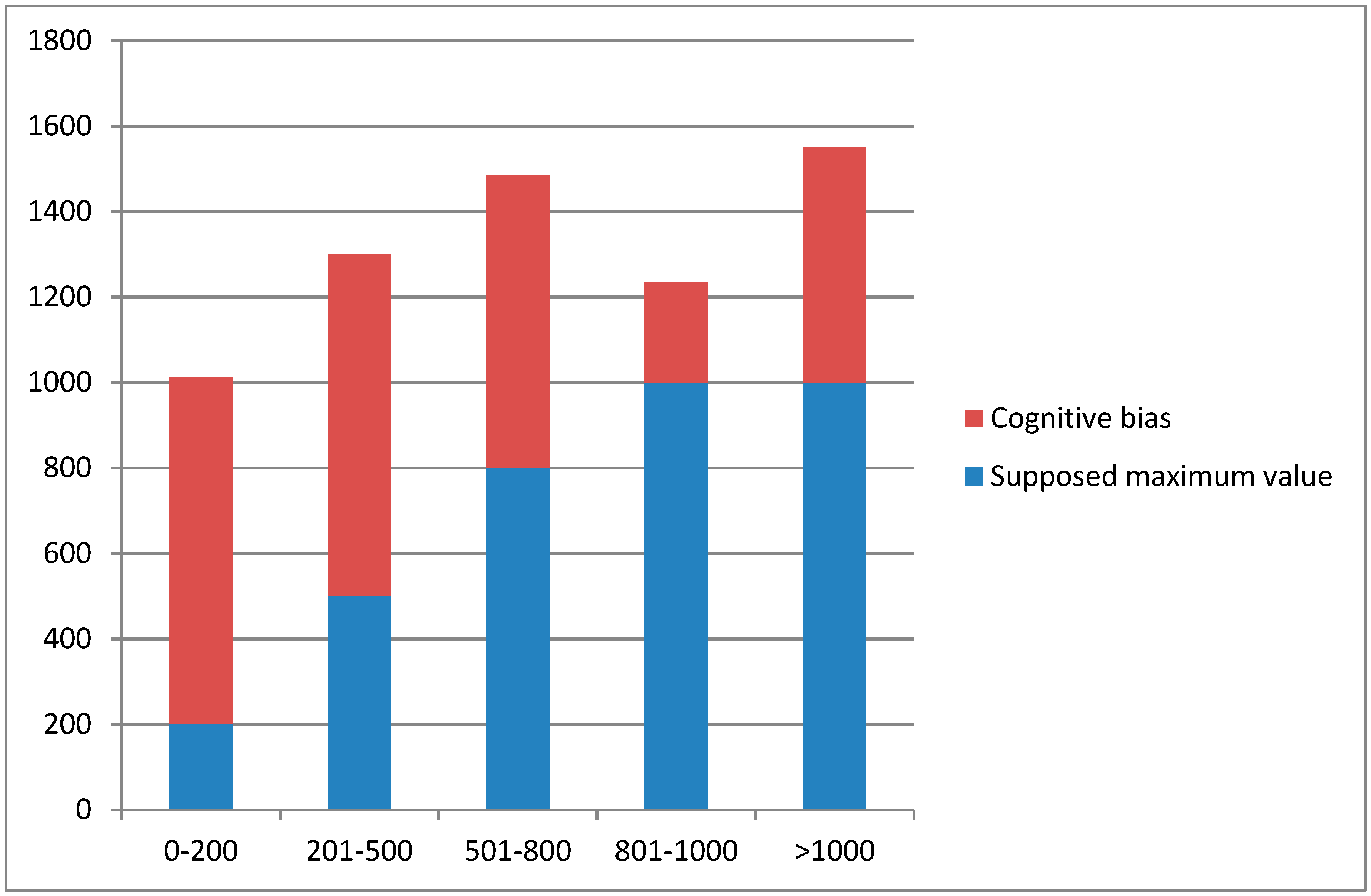
| Causes | Fraction Out of Total Edible Waste (in Percentage) | Wasted Quantity (Average, grams/amily/week) | Wasted Quantity (Average, grams/per capita/week) |
|---|---|---|---|
| Spoiled | 45.8 | 560.6 | 250.9 |
| Personal preferences (I don’t like it) | 25.8 | 316.1 | 137.8 |
| Cooked or served too much | 18.2 | 223.4 | 98.0 |
| Children’s leftovers | 5.7 | 69.5 | 20.3 |
| Other | 2.4 | 29.2 | 11.9 |
| Accidental (burnt, felt on floor, etc) | 1.8 | 22.0 | 9.2 |
| Bought too much/ shopping mistake | 0.3 | 3.5 | 1.8 |
| Total | 100.0 | 1224.4 | 529.9 |
| Food Disposed Separately (%) | Number of Families | Food Waste Average Per Person (g) |
|---|---|---|
| 0–50 | 84 | 610.4 |
| 50–75 | 70 | 662.3 |
| 75–100 | 134 | 537.8 |
| 100 | 100 | 359.2 |
| Total | 388 | 529.9 |
| Variables Analyzed | Impact on Food Waste Production, Per Capita (Yes/NO) |
|---|---|
| Demographics—number of components of the household | Y |
| Demographics—having children | Y |
| Demographics—location (North, Center, South of Italy) | Y |
| Shopping habits—frequency of shopping (see [29] | Y |
| Consumption habits and diets—eating healthy | Y |
| Disposal of wasted food—separate collection system | Y |
| Shopping habits—buying discounted food products | N |
| Shopping habits—place of shopping (see [29] | N |
| Shopping habits—preparing a list(see [29]) | N |
| Motivations | N |
| Consumption habits and diets- eating out | N |
| Provided Options | Number of Families That Selected the Option | Average FW of Group of Respondents |
|---|---|---|
| 0–200 g | 141 | 1010.9 |
| 201–500 g | 167 | 1301.7 |
| 501–800 g | 59 | 1484.9 |
| 801–1000 g | 16 | 1235.4 |
| More than 1000 g | 5 | 1551.8 |
| Total | 388 | 1224.4 |
© 2019 by the authors. Licensee MDPI, Basel, Switzerland. This article is an open access article distributed under the terms and conditions of the Creative Commons Attribution (CC BY) license (http://creativecommons.org/licenses/by/4.0/).
Share and Cite
Giordano, C.; Alboni, F.; Falasconi, L. Quantities, Determinants, and Awareness of Households’ Food Waste in Italy: A Comparison between Diary and Questionnaires Quantities. Sustainability 2019, 11, 3381. https://doi.org/10.3390/su11123381
Giordano C, Alboni F, Falasconi L. Quantities, Determinants, and Awareness of Households’ Food Waste in Italy: A Comparison between Diary and Questionnaires Quantities. Sustainability. 2019; 11(12):3381. https://doi.org/10.3390/su11123381
Chicago/Turabian StyleGiordano, Claudia, Fabrizio Alboni, and Luca Falasconi. 2019. "Quantities, Determinants, and Awareness of Households’ Food Waste in Italy: A Comparison between Diary and Questionnaires Quantities" Sustainability 11, no. 12: 3381. https://doi.org/10.3390/su11123381
APA StyleGiordano, C., Alboni, F., & Falasconi, L. (2019). Quantities, Determinants, and Awareness of Households’ Food Waste in Italy: A Comparison between Diary and Questionnaires Quantities. Sustainability, 11(12), 3381. https://doi.org/10.3390/su11123381






